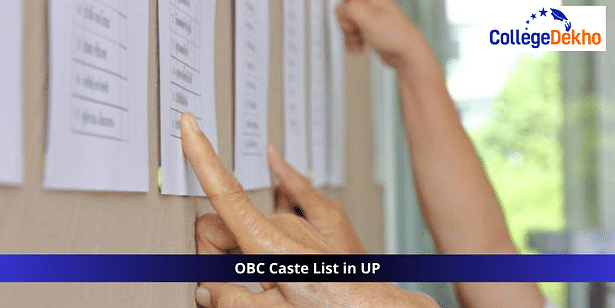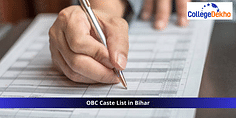
OBC Caste List in UP: When referring to castes that are economically or educationally backwards, the Indian government uses the aggregate term 'Other Backward Class' or OBC. This is one of the recognised population categories used in India, along with Scheduled Castes, general castes, and Scheduled Tribes (SCs and STs). The world's largest subdivision, Uttar Pradesh (UP), is one of the most populated states in India. With its population, it would rank fifth in the world, behind only China, India, the United States, and Indonesia if it were an independent country.
The UP State Local Bodies Dedicated Backward Classes Commission released a report in 2023 that stated that OBCs make up between 37% and 41% of the state's urban population. Approximately 4.78 crore people live in UP's urban areas. A total of 1.76 crore OBCs (or 37% of the population) and 2.4 crore general category members — including Muslims (49%), 65 lakh SCs (14%) and 1.03 lakh STs — are listed in the prolonged, 505-page report. In this article, we will discuss the OBC caste list in UP along with other benefits for OBC communities.
Related Articles:
Recent Updates to the OBC Caste List
The state government has included 17 classes in the scheduled OBC caste list in UP. Following their removal from the Other Backward Castes (OBC) category, the list of castes that have been added includes — Kewat, Bind, Nishad, Mallah, Kashyap, Machua, Dhivar, Bhar, Batham, Prajapati, Kahar, Pottar, Tuhaha, Dhimar, Manjhi, Rajbhar, and Gaur. Due to court involvement, the previous attempts by the administrations of the BSP and SP to bring these castes within the SC category have been unsuccessful. This action is interpreted as an attempt by the Yogi Government to remove legal obstacles that have previously delayed the issue to grant these economically and socially disadvantaged people the benefits of the reservation. The remaining OBC caste groupings will have more room in the OBC quota as a result of the modification.
OBC Caste List in UP: Updated List
As discussed, the OBCs have witnessed social and economic mobility. The following table represents a comprehensive OBC caste list in UP.
Marchha | Rangrez, Rangwa | Lodh, Lodha, Lodhi |
|---|---|---|
Lodhi-Rajput | Lohar, Luhar | Saifi |
Lonia, Noniya, Luniya | Gole Thakur, Nunere | Sonar |
Sunar | Halwai | Hajjam (Nai), Salmani |
Nai | Sain (Nai) | Halalkhor, Hela |
Lalbegi (other than those who are included in the list of Scheduled Castes) | Atishbaz | Dhobi (other than those who are already included in the list of Scheduled Castes for UP) |
Tatwa | Mewati, Meo | Saqqa-Bhisti, Bhisti-Abbassi |
Koshta/Koshti | Khumra, Sangtarash, Hansiri | Patwa, Patua, Pathar (excluding Kharewal or Khandelwal, Agarwala, and Deobansi who are sub-caste of Baniya and Kharwar who claim to the rank of Rajput) |
Darugar | Madari | Nalband |
Sais | Darzi | Dhivar |
Dhiver | Naqqal | Nat (excluding those who are included in Scheduled Castes) |
Raj (Memar) | Nayak | Faqir |
Banjara Mukeri | Ranki, Mekrani | Barhai, Badhai, Viswakarma, |
Ramgarhia | Bari | Bairagi |
Bind | Biyar | Bhar |
Bhurji or Bharbhuja, Bharbhunja | Bhooj, Kandu | Bhathiara |
Mali | Saini, Baghban | Manihar, Kacher, Lakher |
Lakhera (excluding the Lakhera sub-caste of Brahmans in the Tehri Garhwal region) | Churihar | Murao |
Murai Maurya | Momin (Ansar, Ansari), Julah | Mirasi |
Muslim Kayastha | Naddaf (Dhunia), Dhunia, Mansoori, Behna | Kandere, Kadere |
Pinjara | Bhand | Mochi (excluding those who are included in the List of SC of Uttar Pradesh) |
Sheikh Sarvari (Pirai), Peerahi | Aheria/ Aheriya | Bot (omits ‘Bhotia’ who is already on the list of STs in UP) |
Kuthaliya Bora (belonging to Almora, Pithoragarh, Bageswar and Nainital Districts) | Kalal | Kalwar, Kalar |
Dohar | Kasera, Thathera, Tamrakar | Kalaikar |
Rai Sikh (Mahatam) | Unai Sahu | Gada |
Ahir | Yadav | Arakh |
Arakvanshiya | Kachhi | Kachhi-Kushwaha, Shakya |
Kahar | Tanwar, Singhariya | Kewat or Mallah |
Kisan | Koeri | Koiri |
Kumhar, Prajapati | Kurmi | Kurmi-Sainthwar/Kurmi-Mall, Kurmi- Patanwar |
Kasgar | Kunjra | Rayeen |
Gosain | Gujar | Gaderia |
Gaddi | Ghosi | Giri |
Chikwa | Qassab, (Qureshi), Kasai/ Qassai | Chak |
Chhipi, Chhipe | Jogi | Jhoja |
Dafali | Tamoli | Barai, Chaurasia |
Teli, Samani, Rogangar | Teli Malik (Muslim), Teli Sahu | Teli Rathore |
Significance of the OBC Caste List
Other backward classes (OBCs) in UP are predicted to make up more than 50% of the state's population, according to estimations made by the state administration in response to the demand for a caste census. Based on the same data, the largest OBC caste is the Yadav community, with a 19.40% share, followed by the Kurmis and Patels with 7.4%. Of the overall OBC population, Nishads, Mallahs, and Kevats make up 4.3%, Bhars and Rajbhars are 2.4%, Lodhs make up 4.8%, and Jats make up 3.6%. As per the UP State Local Bodies Dedicated Backward Classes Commission, there should be a 27% quota for OBCs in Uttar Pradesh due to their poor economic standing and ongoing social and educational obstacles.
Related Articles:
Understanding the Criteria for Inclusion
The landholdings and economic affluence of India's higher OBCs expanded significantly during the Green Revolution; they also went to school and started actively participating in government employment. In addition, OBC leaders acquired enough political clout to surpass upper caste lawmakers in the majority of north Indian states following the abatement of the Mandal agitation in that region. As a result, some North Indian states established governments headed by OBCs. They ultimately asserted that they had reached the high ritual rank of Sanskritisation. Nevertheless, many other OBC populations were excluded from the development process as a result of the OBC consolidation in various northern Indian states.
As seen by the establishment of political blocs in the state after 1995, wherein these three castes dominated both sides, the dominating Backward Castes, namely Kurmi, Koeri, and Yadav, cornered the political and economic wealth. The following is a list of places where backward classes are reserved:
- Educational Institutions
- Government Hostel
- Government Jobs
- Government Quarters
- In shops built by the Municipal Corporation, the Municipality
- In the buildings, plots, and commercial plots of the Development Authority and Housing Development Council
- In the shops of Mandi Parishad
- Technical Educational Institutions (Reservation in CPMT, Engineering)
- District panchayat president, the village head, etc. where there is a reservation available
Accessing Benefits as an OBC Member
The federal and state governments are implementing several programmes and policies to raise the status of OBCs. The OBC caste list in UP benefits from various aspects, such as:
- Seats in government institutions like the IIMs and IITs, as well as positions like IPS, IAS, and so on, are subject to a 27% reservation quota.
- Many exams, like the UPSC Civil Services Exam, now have a revised maximum age limit. Conversely, there are fewer restrictions on the number of test administrations. Also, there is an exemption for cut-off markers.
Related Articles:
How to Verify OBC Status in UP?
The Government of Uttar Pradesh offers its citizens an online portal called UP eDistrict as a service. Currently, eDistrict UP offers 269 services, including the ability to apply for scholarships, caste certificates, income certificates, domicile certificates, and more. The following is a discussion about the step-wise procedure to verify the OBC caste list in UP status.
Step-wise Procedure to Verify OBC Status
The following are simple steps by which anyone can verify their status from the OBC caste list in UP status.
Step 1: Visit the official website of the UP’s Department of Backward Classes Welfare.
Step 2: Click on ‘Certificate details’ on the homepage and enter your issued updated certification number.
Step 3: Click on ‘Search’ to see your caste certificate details, active status, and other crucial data associated with it.
Step 4: Make any required changes and take a printout for future reference.
Documents Required to Check OBC Caste Certificate Status
If you want to see the progress of your online caste certificate application, you must input the certificate application code that the official state council sent to you. However, you must include the following information to confirm the caste certificate information on any current certificate:
- Your full name
- The number of your previously valid caste certificate
- New caste certificate number
- Name of the issuing body
- Issuance date
Cross-checking whether your class belongs to the OBC caste list in UP is essential to reap the complete benefits of beneficiaries offered by the government of India. Also, with the addition of 17 classes to the state government's scheduled OBC caste list in UP, the modification will provide the existing caste groupings with extra room in the OBC quota.

















Similar Articles
OBC Caste List in Bihar
GTU Grading System: Calculation of SPI
KTU Grading System: A Complete Guide
How to Download Aadhaar Card?
List of Documents Required for SSC CHSL Application Form 2024: Image Uploading Process, Specifications
SSC CHSL Application Form Correction 2024: Check Dates, Process, Details to Edit